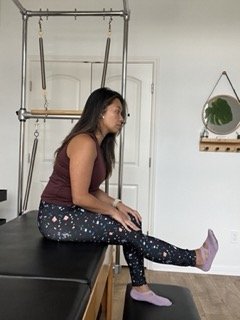Is your pulled Hamstring a Sneaky Sciatic Nerve in Disguise
12 years in the game of being a Physical Therapist Specializing in Spine care - I have learned a few things about the sciatic nerve.
1 big takeaway - Sciatic nerve tension is often confused or misdiagnosed for a Hamstring strain or Pull!
I've had several patients come to the clinic with a script of "Hamstring Strain Evaluate & Treat" to only be dumbfounded by evaluation findings. I use to put all my trust in those MD diagnosis labels, and while most are correct - I have learned to trust my instincts and medical degree to come to my own conclusions.
While back pain and Sciatic pain is affected by multiple factors- I want to share with you some simple ways to differentiate between the two conditions. In hope to equip you with information to get you the care you need!
Both conditions present with pain and symptoms along the posterior thigh that can be achy and dull, or intense and sharp. Both conditions can occur after a heavy work out session. Both conditions can feel better with ice and rest, and aggravated with stretching leg out too far while walking and sitting.
Let’s go over 2 tests that can help differentiate a Hamstring Strain from an irritated Sciatic Nerve.
Seated Root Test: sit in a chair, extend symptomatic leg by straightening the knee. This will be a painful position for both a hamstring strain and sciatic nerve tension. So there are ways to distinguish the two. First- increasing lumbar flexion (bending forward of the back) will increase symptoms ONLY for sciatic tension. AND increasing ankle Dorsiflexion (bending foot upward) will increase symptoms ONLY for sciatic nerve tension.
A POSITIVE SIGN for Sciatic Nerve tension: would be when nerve symptoms increase WITH ankle bending up AND decreasing with ankle bending down. Another indication would be LOCATION of pain. People that complain of pain higher up into the buttock or low back during this test is even more indicative of Sciatic Nerve tension, because the hamstrings do not begin until it’s attachment point below the buttock known as the sits bone or ischial tuberosity.
Increases posterior thigh pain
Decreases posterior thigh pain
2. Active Prone Hamstring curl: lying face down, bend affected knee by engaging back thigh to draw heel of foot to buttock. This can be done with overpressure from a clinician or -as seen in this video- solo with a heavy resistance band. I have this activation performed in prone to reduce lumbar disc pressure, and nerve interference with the hamstring curl. Having the affected knee bend puts the sciatic nerve on slack, while still performing a hamstring activation.
A POSITIVE SIGN for a Hamstring Strain or Pull during this exercise is pain in the posterior thigh. Additional signs indicative of a Hamstring strain includes bruising or discoloration along the posterior thigh.
Performing these TWO tests can help begin the differential diagnosis between a Hamstring Strain and Sciatic Nerve tension. But be aware there is also SOO much more that goes into a True Comprehensive Evaluation and REHABILITATION PROGRAM.
If you experience a POSITIVE SIGN for EITHER OF THESE - I highly recommend getting personalized care and rehabilitation that you deserve. Often times I encounter patients that have had a long standing muscle or nerve injury that go unresolved for months by doing exercises that are more harmful than helpful from random DIY exercises.
Stretching a strained Hamstring can prolong the injury!
Stretching a Sciatic Nerve that is having restriction in mobility and blood flow can prolong the injury!
You deserve quality and highly skilled help from the Movement Specialists that went to school to know exactly what to do- PHYSICAL THERAPISTS!
If you find yourself not getting the care you need- keep looking!
I am here to help those that have ‘done it all and still not feeling as good as they want’. If this sounds like you- be sure to begin with a Free Discovery Call to see if we are a good fit! Sign up HERE.
xx- Christa Ordonez, PT, DPT
Your PT and Pilates Bestie
**My blog is informational for those willing to learn about their body. If you experiencing pain and challenges with movement-be sure to reach out to me or your Local Physical Therapist. Personalized care is always safest & best!



